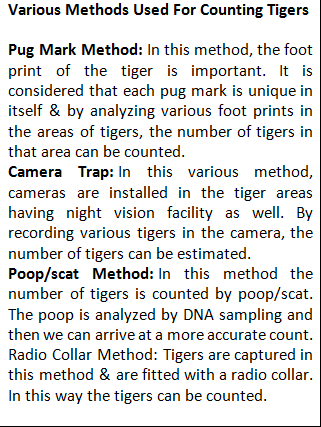

Tiger Census Report, released in July 2019 has been clouded by doubts over the counting methods. Now for the first time, NTCA has acknowledged the need for greater transparency in census.
Context
Tiger Census Report, released in July 2019 has been clouded by doubts over the counting methods. Now for the first time, NTCA has acknowledged the need for greater transparency in census.
About
- The Tiger Census Report 2019, released in July, put the population at 2,967, a 33 per cent increase over 2014 when tigers were last enumerated. But the achievements in conservation have been clouded by doubts over the counting methods.
- Investigations revealed that the tiger census had over-reported the population by 16 per cent.
- Following that investigation, the National Tiger Conservation Authority (NTCA) — which along with the Dehradun-based Wildlife Institute of India (WII) conducts the tiger census — has taken the first step towards introducing correctives. It has admitted the necessity of “bringing more scientific robustness to the exercise”.
- In the 1970s, when India embarked on Project Tiger, conservation authorities sought to identify every tiger in the wild from its paw print. But scientists criticised this method as highly subjective and riddled with the possibilities of duplication.
- Sariska National Park in Rajasthan had lost all its tigers in 2005 but a year before, pug mark surveys had claimed that all was well at the reserve.
- Since 2006, tiger audits have relied on camera traps, they have estimated the animal’s prey base and tried to gauge the health of the tiger’s habitats. All this has helped the NTCA and WII to arrive at more realistic numbers. But doubts over methodology have persisted. The quality of camera traps has been a major issue in several reserves and scientists have contended that the NTCA and WII have not devised sound protocols.
Criticism of Tiger Census Methods
- The Camera Trap estimation of tiger numbers in source populations, in tiger reserves was poorly done which was a violation of capture-recapture modeling.
- The estimated of prey species densities from line transects were poorly done which is against the current practices.
- The complicated, ‘double-sampling’ based regression model is somewhat flawed and obsolete approach.
- Their statistical methodology of relying on calibrations and regressions based on track and dung surveys to generate wider estimate tiger numbers in wider landscapes was also deeply flawed.
- Based on Enumerators Subjective Ability to Identify Individual Tigers from Pugmarks.
- Variation in Pugmarks with substratum, gait, and observers recording skills
- Not possible to obtain Pugmarks from all Tiger Occupied Landscapes.
- Camera trap method becomes useless in areas having salty waters. It damages the camera.
- Not always that someone will get the poop of all the tigers in an area.
- In Radio Collar Method the method fails when the concerned tiger enters the salty water.
|
Project Tiger and National Tiger Conservation Authority (NTCA)
|
Conclusion
NTCA acknowledged the need for “accountability” that will translate into effective tiger conservation. It is the right time to being in peer-review of the tiger census.


